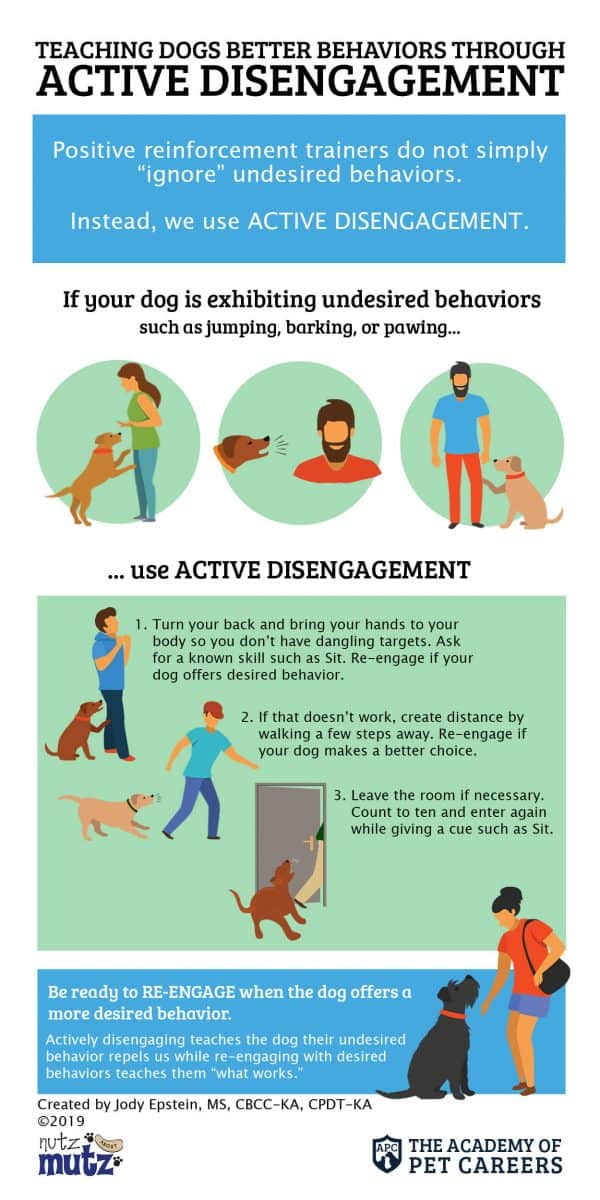Active Disengagement

We're Not Just Ignoring "Bad" Behavior, We're Using Active Disengagement
There are two main philosophies when it comes to dog training. One (often considered ‘old school’) is compulsion training. This is a style of training that uses tools such as choke chains, prong collars, or electronic training collars to correct the dog whenever they do the wrong thing. The other philosophy is cooperative training. This is what we use here at The Academy of Pet Careers. In this style of training, we use treats, toys, love, praise, and anything else the dog likes and wants in order to motivate them to work with us. We set the dog up for success so that we can say “Yes! I love that. Please do it more often.”
These two training philosophies often find themselves at odds with each other. One of the more common arguments used by compulsion trainers to explain why their methods are better than cooperative training is this: Positive reinforcement trainers just ignore bad behavior, and you have to correct the bad behavior if you want to fix the problem.
The problem with this argument is that it is actually a misunderstanding of what we are doing.
Let’s take jumping as an example behavior. If I were simply ignoring the behavior, I’d sit there and carry on a conversation with the other person in the room, and just let the dog continue to jump on me indefinitely. But that is not what positive reinforcement trainers are doing when we say “ignore the behavior.” In fact, I think that’s a poor way to describe what we’re really doing. Let me explain…
The Concept of Active Disengagement
I don’t just ignore the dog and let him jump on me indefinitely while trying to pretend it’s not happening. Instead, what I am doing is an Active Disengagement. Active disengagement is far more than simply ignoring behavior. If the dog jumps on me, I look away from him, pull my hands out of reach so they’re not targets, and turn away from the dog. If necessary, I will walk away. I’ll even leave the room and put a closed door between us if necessary.
Then, I will give a single cue such as Sit or Down (lie down) and wait for the desired behavior. Or, if the dog doesn’t yet have those cues well learned, I’ll simply wait until the dog makes a better behavior choice such as sitting or retrieving a toy or even just standing politely near me (four on the floor). Then, when the dog is doing a more acceptable behavior, I will begin to Actively Engage with the dog. If the dog jumps again, I will actively disengage.
How It Works
What am I teaching the dog when I do this? I am teaching the dog that behaviors such as jumping or demand barking repel me. Those behaviors physically push me away from him – even out of the room! And other behaviors (not jumping, or simply being quiet) attract me. Those alternative behaviors physically bring me to the dog and initiate the social interaction that the dog is hoping for by jumping or barking.
By doing this, the dog learns that his instinctive high-energy behaviors do not get him what he most desires in that moment, but other, calmer behaviors do get that social need met – and quickly.
So, remember, when you’re teaching your pup to stop doing undesired behaviors, it’s not enough to simply ignore – and that is not what your trainer is telling you to do. Instead, you want to use Active Disengagement along with active engagement to teach your pup the behaviors you most want him to do. Happy training!
Author - Jody Epstein
Jody Epstein is a certified behavior consultant, certified professional dog trainer, and holds a master’s degree in animal behavior from Tufts University. She has been training professionally for more than 12 years and is pleased to be part of the Academy of Pet Careers team, teaching the next generation of trainers. Look out for her blogs on all things dog training and animal behavior.

